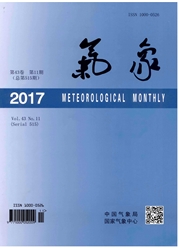

 中文摘要:
中文摘要:
通过统计分析,本文研究了强ElNino年西北太平洋及南海热带气旋(TC)的活动特征并详细分析了造成2015年TC活动的大气环流特征。强ElNino年上半年TC生成偏多,台风活跃季(6—10月)TC生成偏少,登陆我国TC偏少,TC的生成位置较偏东南,并且台风路径多发生向东北的偏转。2015年生成的TC符合这一规律。E1Nino成熟前赤道西太平洋存在大面积的西风异常,同时El Nino使得西北太平洋地区对流活动受到抑制,而副热带高压位置偏南,导致热带辐合带(ITCZ)位置偏南,这些因素综合作用导致了2015年台风季TC数量偏少。强E1 Nino年台风不但整体强度偏强,个体台风的强度也偏强,这是由于强El Ninio年的副热带高压面积和强度偏小,有利于TC活动的加强。强El Nino年西北太平洋东南部生成的TC偏多,并且强度偏大;东北部生成的TC偏少。2015年的TC活动特征符合上述规律,生成于我国南海的TC个数少、强度偏小。从路径上来看,2015年台风路径多呈抛物线型,发生了向东北方向的转向,进入我国南海的TC明显偏少,这与副热带高压西伸脊点偏东,西北太平洋上空500hPa异常的西北气流有关。
 英文摘要:
英文摘要:
Based on the CMA-STI tropical cyclone best track data from 1951 to 2015, the tropical cyclones activities over the Western North Pacific (including the South China Sea) in strong El Nino years are analyzed. The features of tropical cyclones in 2015 and their corresponding atmospheric circulation characteristics are discussed as well, for the year 2015 is the strongest El Nino year since 1997. The results show that in strong E1 Nino years, there are a larger number of TCs in the first half of the year and smaller number of TCs from June to October, and fewer TCs land in the whole year. The TC genesis is to the southeast of its normal and they tend to recurve from northwestward to northeastward. TC activity in 2015 is in accordance with the laws above. There is a large-scale anomalous westerly over the western equatorial Pacific be fore El Nino gets mature, and a strong El Nino weakens the Walker circulation. Both of them suppress the convection. Besides, the subtropical high is located further south, making the ITCZ move southward. All these factors result in fewer TCs in 2015. In strong ElNino year, the strength of all the TCs is stronger, and this is due to the weaker intensity and smaller area of the subtropical high. There are more TCs form ing in the southeast part of the WNP with stronger intensity, and the number and intensity of TCs in the northeast part is in the opposite condition; TCs generating in the SCS is fewer and weaker than normal as well. The TC activity characteristics in 2015 accord with the above rules and they are attributed to the eastward western ridge point of subtropical high and an anomalous northwesterly over the WNP at 500 hPa.
 同期刊论文项目
同期刊论文项目
 同项目期刊论文
同项目期刊论文
 期刊信息
期刊信息
